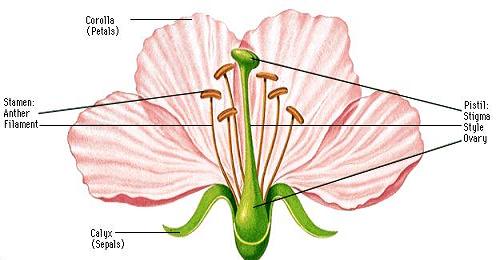
 |
|
|
|---|
| Many kinds of flowers grow in clusters called inflorescences. In some species, such as bridal wreaths and snapdragons, the individual flowers in each cluster are easy to identify as flowers. In numerous other species, however, the inflorescence looks like one flower and the individual flowers that make up the inflorescence look like petals. |
 |
|---|
These species include the many members of the composite family, such as asters, chrysanthemums, daisies, dandelions, and sunflowers. Among the members of the composite family, the flowers grow from a head at the tip of the flower stalk. Each head has several or many flowers, depending on the species. A dandelion head, for example, may have 100 or more tiny yellow flowers. Each flower, or floret, looks like a petal but consists of a calyx, a corolla, stamens, and a pistil.One petal makes up the corolla. The dandelion florets grow so close together that only their corollas can be seen. The flowers of some plants grow in plain, tassellike inflorescences called catkins. A catkin is composed of naked flowers-that is, flowers that lack both petals and sepals. Plants that have catkins include alders, poplars, and willows.

Many plants that have inflorescences also have leaflike structures called bracts just beneath each flower cluster. In most cases, bracts are small, green, and barely noticeable. But in a few species, they are so large and showy that most people mistake them for part of the flower. The showy "petals" of bougainvilleas, dogwoods, and poinsettias are bracts. The flowers themselves are small, plain-looking inflorescences at the center of the bracts.
Among most species of flowering plants, each plant bears flowers that have both stamens and pistils. Such flowers are called perfect flowers. In some species, however, each plant bears flowers that have either pistils or stamens, not both. Such flowers are called imperfect flowers. If a flower has pistils but no stamens, it is called a pistillate flower. If it has stamens but no pistils, it is called a staminate flower. In some species, the staminate and pistillate flowers are on the same plant. Such species are known as monoecious species. They include begonias, oaks, and squashes. Among dioecious species, the male and female flowers are on different plants. Dioecious species include poplars, willows, and American holly. |
|---|
.. |
| HOME |
|---|
| GLOBAL WARMING |
| INDONESIA FOREST |
| INDONESIA BIODIVERSITY |
| CDM IN INDONESIA |
| MANGROVE FOREST |
| THE IMPORTANCE OF TREES |
| FOREST AND ECOLOGY |
| KIND OF CONSERVATION |
| KIND OF BIODIVERSITY |
| HOW PLANTS GROW |
| FOREST PICTURES |